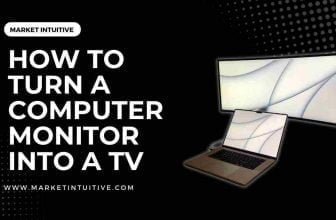LED vs LCD: Which One’s Best For You?

When choosing the right monitor for your digital setup, LED vs LCD monitors are the two most popular choices. Both options offer a wide range of features and come in various sizes, making them great choices for various applications.
However, while they both have their advantages, they also have differences that must be considered when making a decision. LED monitors feature a slim, lightweight design that makes them ideal for portability, while LCD monitors are bulkier and more durable. LED monitors offer superior image quality, with deeper blacks and brighter whites, while LCD monitors are more affordable but lack the same image quality. Choosing LED and LCD monitors ultimately depend on your individual needs and budget.
Keep reading this comprehensive guide on LED vs LCD to know more about them.
Which Monitor Is Right For You Between LED vs LCD?
Although they use quite different technology, many people wrongly think that LED (light-emitting diode) and LCD (liquid-crystal display) monitors are similar (backlighting and display, respectively). While every LCD monitor has an LED backlight, not every LCD has an LED screen.
Nowadays, LEDs are more commonly used in LCD monitor backlighting than traditional CCFLs.
A CCFL-backlit LCD monitor is much thinner, lighter, and consumes less power than an LED-lit LCD monitor. Additionally, LEDs last longer than CCFL bulbs. When switching from a CCFL LCD to an LED LCD, you might not notice a significant gain in picture quality, but LEDs might illuminate the screen more evenly than CCFLs do.
Let’s dive deeper to understand the nuances.
What is an LED Monitor?
LEDs (light-emitting diodes) light up LED monitors, which are tiny light bulbs similar to mini Christmas lights. The LEDs behind the screen are arranged differently, either in full-array LED backlighting or edge lighting. A few high-performance, contemporary monitors include mini-LEDs, allowing even more precise lighting control.
A monitor with full-array lighting has diodes evenly distributed behind the screen, resulting in even lighting throughout the entire display. Since the light of an edge-lit monitor is spread evenly with a sheet of plastic, manufacturers can save money, resulting in low costs.
Some LCD HDR computer monitors have local LED dimming functionality, which allows you to dim specific areas of the screen based on what you’re watching.
This gives you an inky black screen with brighter, more colorful imagery since the screen is not evenly backlit all the time. With mini-LED monitors, this technology is more effective as diodes are about 1/5th the size of standard LEDs, allowing for more precise dimming.
What is an LCD Monitor?
A liquid crystal layer sandwiched between sheets of polarized glass controls the light on the LCD monitor. The light penetrates the liquid crystal layer and is produced from an external source. The electrical current alters the crystals’ alignment, allowing or blocking light based on color. Historically, an LCD monitor’s backlighting has been CCFL, but LED backlighting is common today.
There are three main panel types within the LCD monitor category, each of which has pros and cons.
TN (Twisted Nematic) Panels– Budget monitors typically employ this type of monitor panel. They provide ~1ms response times, which makes them ideal for fast-paced games such as first-person shooters. However, they have poorer color reproduction/contrast and fewer viable viewing angles than other panel types because of their inferior color reproduction/contrast.
VA (Vertical Alignment) Panels– VA panels sit between TN and IPS in terms of color accuracy and viewing angles, giving you excellent black tones and accurate colors. The response time, however, is slower than that of TN panels.
IPS (In-Plane Switching) Panels– IPS screens have become increasingly popular due to their excellent color accuracy and wide viewing angles (almost 180°). Because response times on VA panels aren’t as fast as those on TN screens, they usually have a response time of 4 to 8 milliseconds, which is important for intensive PvP gaming, designers and professionals who need precise colors can benefit from this panel type.
OLED vs QLED Monitors
LED displays have undergone further development, and now you get OLED and QLED screens in the market.
OLED stands for organic light-emitting diodes, and it uses an organic compound to create outstanding high-contrast images – OLED screens are more environmentally friendly. They are thinner than a standard LED screen as they don’t require a thick LED backlighting behind the screen to illuminate it.
On the other hand, you have QLED screens that are created and patented by Samsung. The QLED screens offer more crisp images, creating light with a shorter wavelength.
The Q in QLED stands for Quantum Dot. The screens have an additional layer between the LCD screen and the monitor’s backlight. This layer allows light to pass through easily and produce better colors than an ordinary LED screen.
LED vs LCD, Which Is Better?
Which one is better, LED vs LCD monitors? Which one should you buy?
LED monitors will prevail when comparing the two because they provide many benefits, such as:
- LED vs LCD: Longer Life
LCD monitors are known to last between 30-50,000 hours. On the other hand, LED monitors can last up to 50,000 to 100,000 hours.
- LED vs LCD: Slimmer Design
LED screens come slimmer than their LCD counterparts. This gives them a sleek and elegant look and takes less space.
However, consider an LCD screen if you work on a tight budget. Besides the cost, LED performs better than LCD screens in all aspects.
If you want to find out the type of screen you already have, you can check out the screen’s model number. The model number can tell if the screen is an LED or LCD. You can also see if the screen has an LED sticker anywhere, as they typically come labeled.
- LED vs LCD: Cost
If you are trying to cut energy costs, an LED screen will be a better option between two as it is more energy-efficient. However, LED screens are more expensive than their LCD counterparts. As such, you can expect to pay more initially.
- LED vs LCD: Better Color
LEDs will be the better option for enjoying more realistic images. The screen offers you better color than other screens in the market. Additionally, it offers a better contrast, which is the range between the darkest blacks and brightest whites on the screen. The enhanced contrast ensures you end up with the most realistic images.
LED vs LCD: Which To Buy?
When it comes to picture quality, LED TVs outperform CCFL LCD TVs. LED backlighting, in particular, is a technology that manufacturers promote because it makes their TVs more energy-efficient than CCFL LCD TVs. You may save money on your electricity bill by purchasing an LED TV. The money you save on your bill might eventually offset the extra cost.
Therefore, LED TVs are a better option than older LCD TVs.
LED vs LCD Monitor: Which Is Best For Eyes?
If you are working in an office, you may have to spend eight or more hours in front of your monitor. If you keep looking away from the screen due to eye fatigue and strain, it will affect your productivity. The eye strain can also cause headaches in some people.
As such, you should go for a monitor that reduces eye strain and offers better colors and contrast to help keep you focused.
So, between LED Vs LCD monitors, which one is the best for your eyes?
LED monitors feature better dimming options without sacrificing picture clarity. They also come with features that reduce eye strain, making them the ideal option if you spend long hours in front of the screen.
Alternatively, you can go for LCD screens with a refresh rate of 120Hz. The LCD screens also offer a wider variety of viewing angles, which can offer better comfort.
LED vs LCD Monitor: Which Is Better For Gaming?
You can use a monitor for more than just watching movies or working; you can also use it for gaming. Whether a gaming enthusiast or someone who enjoys games, you want a monitor that provides the best picture quality.
You want clear images as you tackle your enemies, even the ones hiding in dark corners.
A perfect monitor for gaming should offer you a high refresh rate, low lag, and low response times. A screen response time refers to how fast the pixels change from one image to the next. Lag refers to the delay you experience between pressing a button and seeing the corresponding action on your screen.
Refresh rate refers to how fast the screen updates.
The best monitor for gaming should have a high response time, support a high resolution, and shouldn’t be prone to screen tearing.
You can trust an LED monitor to offer precise and crisp images with the best resolution. This enables you to enjoy clear and lifelike images.
Final Thoughts on LED vs LCD
Do you need help with the best choice between LED vs LCD monitors? Here is the answer, if you spend a lot of time in front of your monitor, you should ensure you end up with the best quality screen. This will ensure that you get high-quality images and also minimize eye strain.
In the battle between LED and LCD, LED is the better option. It offers more crisp and clear images, and it also comes with a sleek and elegant design. However, it can be a little expensive. If you are working on a budget, LCD monitors can make a perfect choice.
Related Article:
Crystal UHD vs LED: Which One Is Best For You?
IPS vs LED Monitor: Which One is Best For You?
FHD vs HD: Which One Is Best For You?






